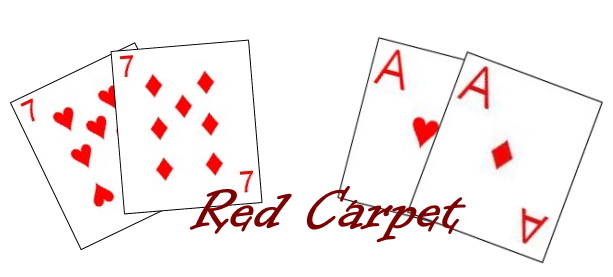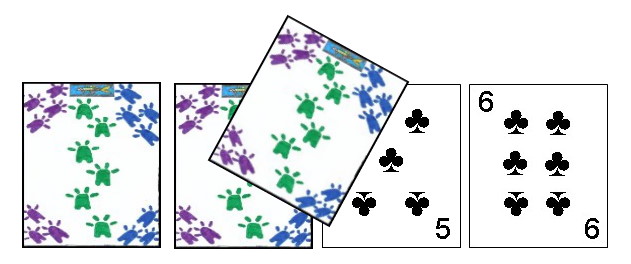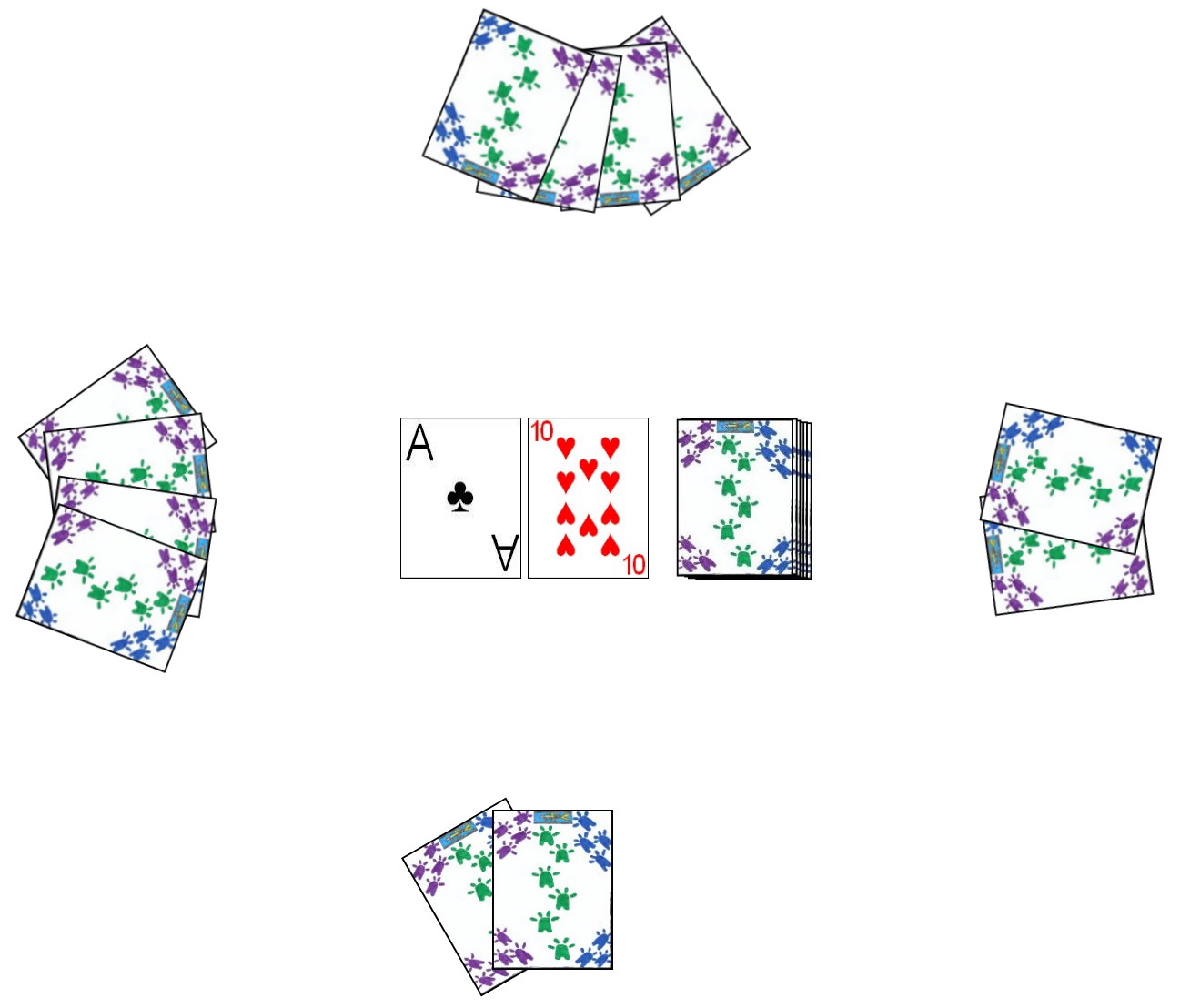How to Play Red Carpet
 Red Carpet is a very unique and original card game created by game designer Mike Church in 2003 while in Budapest, Hungary. The rules for this game have been provided here by specific permission of the creator.
Red Carpet is a very unique and original card game created by game designer Mike Church in 2003 while in Budapest, Hungary. The rules for this game have been provided here by specific permission of the creator.
Notice: The general rule set for the game Red Carpet is copyrighted by Mike Church (michael.o.church@gmail.com) © 2003. You may freely use and distribute the rules as you wish, but commercial use of this game or these rules without his permission is forbidden. Non-commercial use and distribution of the Red Carpet game and it's rules however, is encouraged.
Red Carpet is designed for play by two to four players and uses the 32 card reduced pack. This pack can easily be created from any standard 52 card deck by removing all cards lower than rank 7 from the standard 52 card deck. The cards in this deck have a relative ranking, mostly for purposes of creating sequences. Thus, this ranking of the cards used in this game are as follows (from highest to lowest); Ace, King, Queen, Jack, 10, 9, 8, 7.
 While not used directly in gameplay, the remaining low cards from the deck can also
serve the purpose for showing the total number of bidding points each player
has remaining during the course of the game. To that end, each player should
be provided one card each in the rank of 2, 3, 4, 5 and 6, with each player
receiving these cards all of the same suit, for convenience. At the
beginning of every hand, each player would initially lay each of these cards, face up in front of himself on the table
in a row representing the 20 total initial bidding points that player has. As he spent his bidding points during the game, he would then progressively cover pips (suit markings) from these
cards to represent the number of bidding points he has remaining for that hand. After each hand, each player is provided a new supply of 20 bidding points.
While not used directly in gameplay, the remaining low cards from the deck can also
serve the purpose for showing the total number of bidding points each player
has remaining during the course of the game. To that end, each player should
be provided one card each in the rank of 2, 3, 4, 5 and 6, with each player
receiving these cards all of the same suit, for convenience. At the
beginning of every hand, each player would initially lay each of these cards, face up in front of himself on the table
in a row representing the 20 total initial bidding points that player has. As he spent his bidding points during the game, he would then progressively cover pips (suit markings) from these
cards to represent the number of bidding points he has remaining for that hand. After each hand, each player is provided a new supply of 20 bidding points.
Determination of seating positions and first dealer can be performed in a variety of methods, with draw for high cards a common method. Using this method, each player would draw one card from a shuffled deck, taking seats in the order of the rank of cards drawn, from highest to lowest. If two or more players draw cards of the same rank, those players should discard that card and draw another, and if again drawing a card which some other player has drawn, should continue to draw cards until drawing a unique value card not drawn by any other player. The player drawing the highest card of all is set as the first dealer. The role of dealer should rotate in a counter-clockwise direction after every hand.
Once the players are seated and the first dealer designated, this player should thoroughly shuffle the deck before the deal. After the shuffle and an optional cut by the player at his immediate left, the dealer begins the deal. This consists of dealing two face-down cards to each player at the table, starting with the dealer and continuing in a counter-clockwise rotation around the table. Each player may look at the two cards dealt him but should try to ensure other players do not see them.
The object of the game is to be the first player to obtain 250 or more game points over the course of multiple hands. A player does this by earning these game points each hand, which is usually through obtaining high valued four card combinations at the end of each hand. Players attempt do to this during the hand by "bidding" for additional cards to add to their initial two card hands during play. Each player is entitled to 20 bidding points at the start of each hand and will use these bidding points to purchase certain cards needed to obtain special combinations. These bidding points can be represented in several ways, such as chips or a tally on a score sheet, however the method originally suggested for the game (and the most fun) is to use the lower, unused cards from the 52 card deck to represent the number of points a player currently has.
 To start each hand, the dealer then draws the top two cards from the
remaining deck and places these two cards face-up on the table exposed for
all players to see. A bidding round now begins in which the players bid for
the opportunity to purchase these two cards to add to their existing hand.
For the first round, the bidding starts with the player to the right of the
dealer and continues in a counter-clockwise direction around the table. A
player is not required to bid and may instead pass, however once a player
passes he may no longer bid on the current pair of cards which is currently
in contention for the bidding. The minimum bid is two and the maximum bid a
player may make is equal to the number of bidding points he currently has
remaining. The one exception to the minimum bid of two is if a player has
only one bidding point remaining, in which case that player may make a bid
of one. In order to be considered a legal bid, a bid must be higher, by at least one bidding point, than any previous bid for these same two cards during this bidding round. The bidding continues around the table in a counterclockwise direction until the last high bid is followed by three consecutive passes. The player who made the highest bid then must pay the amount of his high bid and may then take the two cards bid upon and add both cards to his hand. He may also, optionally, decide not to add the cards into his hand but rather discard both cards to a discard pile, out of play. This is called "junking" these cards, and a player may want to do this in order to prevent another player from taking those same cards into their hand instead. The maximum number of cards a player may have in hand is eight, thus a player who wins a bid and already has 8 total cards in hand must junk any additional cards won during that hand. If all four players pass, the cards are also set aside out of play in the discard pile.
To start each hand, the dealer then draws the top two cards from the
remaining deck and places these two cards face-up on the table exposed for
all players to see. A bidding round now begins in which the players bid for
the opportunity to purchase these two cards to add to their existing hand.
For the first round, the bidding starts with the player to the right of the
dealer and continues in a counter-clockwise direction around the table. A
player is not required to bid and may instead pass, however once a player
passes he may no longer bid on the current pair of cards which is currently
in contention for the bidding. The minimum bid is two and the maximum bid a
player may make is equal to the number of bidding points he currently has
remaining. The one exception to the minimum bid of two is if a player has
only one bidding point remaining, in which case that player may make a bid
of one. In order to be considered a legal bid, a bid must be higher, by at least one bidding point, than any previous bid for these same two cards during this bidding round. The bidding continues around the table in a counterclockwise direction until the last high bid is followed by three consecutive passes. The player who made the highest bid then must pay the amount of his high bid and may then take the two cards bid upon and add both cards to his hand. He may also, optionally, decide not to add the cards into his hand but rather discard both cards to a discard pile, out of play. This is called "junking" these cards, and a player may want to do this in order to prevent another player from taking those same cards into their hand instead. The maximum number of cards a player may have in hand is eight, thus a player who wins a bid and already has 8 total cards in hand must junk any additional cards won during that hand. If all four players pass, the cards are also set aside out of play in the discard pile. Once the bidding has ended and the cards are either purchased by a player or discarded, the previous high bidder then removes two more cards from the remaining deck and places them in the middle of the table and a new round of bidding begins, this time with this previous high bidder having the first opportunity to bid on these new cards. The game continues in this manner, with a series of bidding rounds, until one of several occurrences:
- There are no more cards left to bid upon, with the remaining deck having become exhausted.
- Every player has 0 remaining bidding points.
- Every player has exactly eight cards in his hand.
| Card | Scoring Value |
|---|---|
| Ace | 4 Points Each |
| King, Queen, Jack | 3 Points Each |
| 10, 9, 8, 7 | 2 Points Each |
| Combination | Description | Card Point Scoring Adjustment | Example |
|---|---|---|---|
| Pair | Two cards of the same rank. Note that if a player has two different pairs in the hand, this would double the hand and double it again (one double for each pair), for a total multiplier of four times the base value of the cards in that player's hand. | Doubles the base value of cards from the hand |  |
| Three of a Kind | Three cards of the exact same rank. | Triples the base value of the cards from the hand. |  |
| Four card Straight | Four cards in direct sequential order, but of mixed suits. | Triples the base value of the cards from the hand. |  |
| Four card Flush | Four cards all of the same suit but not in direct sequential order | Triples the base value of the cards from the hand. |  |
| Four of a Kind | Four cards all of the exact same rank | Quintuples (multiplies by five) the base value of the cards from the hand. |  |
| Straight Flush | Four cards all of the same suit and in direct sequential order. | Quintuples the base value of the cards from the hand. |  |
| Red Carpet | Both red Aces and both red sevens. This is the highest point scoring combination which can be achieved during a hand. | This hand earns 100 points for the player who manages to create it. |  |
If, at the end of a hand, any player has managed to accumulate an ongoing score of 250 or more points that player is declared the winner. If two or more players have scored 250 or more points, the player with the highest total wins the game. If no player has yet reached 250 points, another hand is thus dealt.